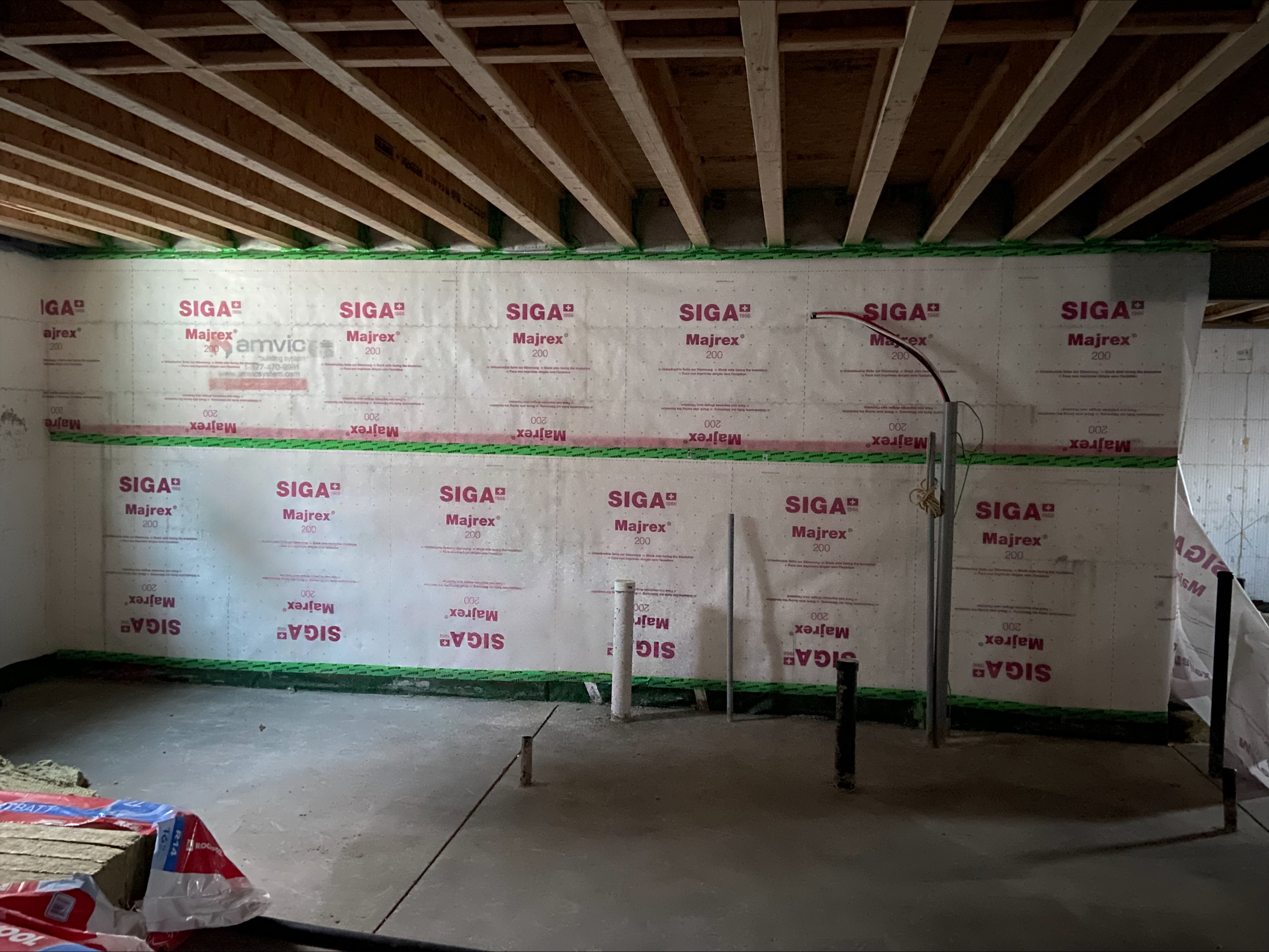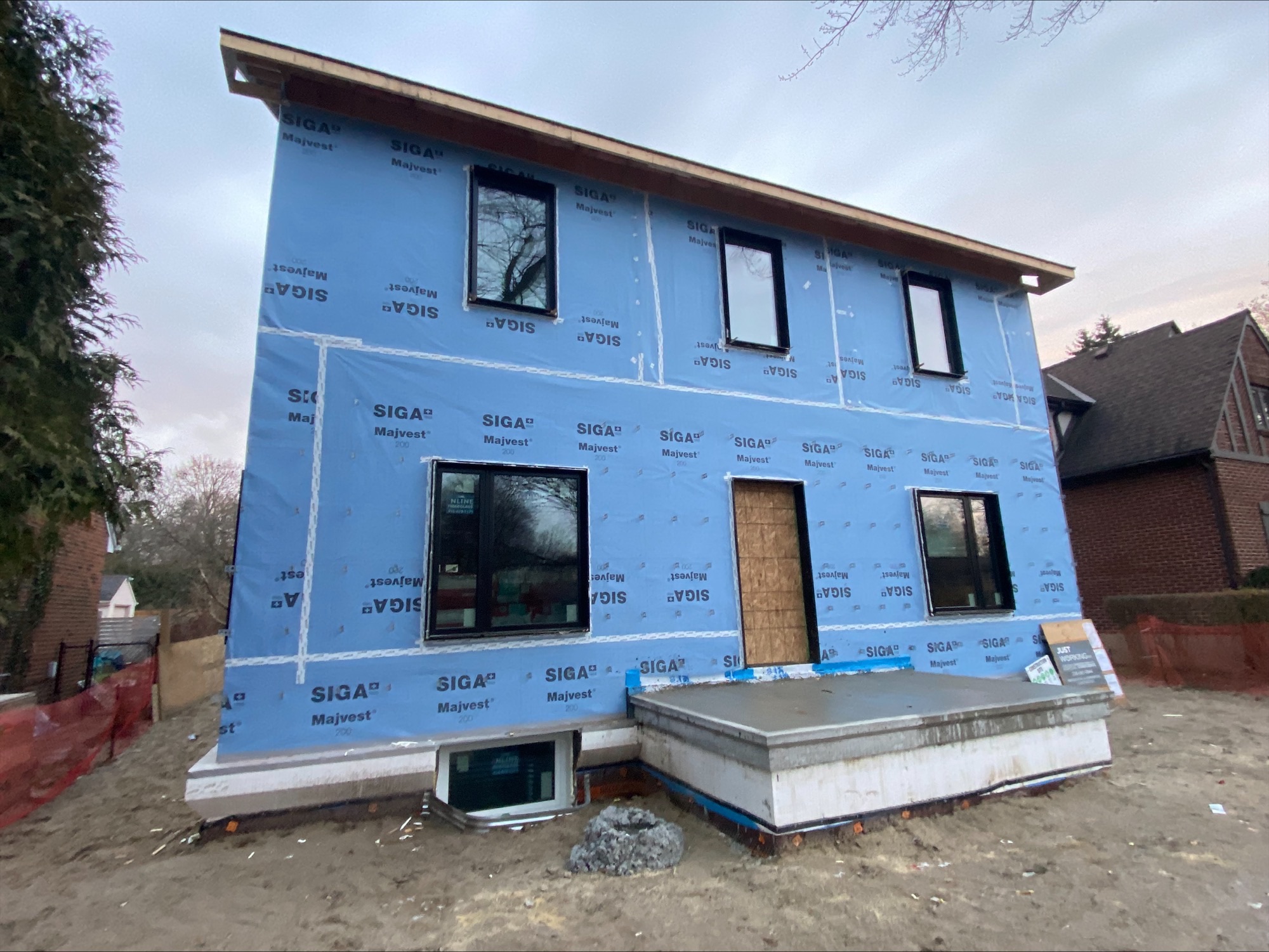Just Working Construction’s (JWC) project, the Hayes Passive House Design, exemplifies the growing demand for energy efficiency and the reduction of operational costs, highlighting the importance of integrating advanced building materials and techniques into construction projects.
By embracing innovations like those we are using in the Hayes Passive House project, we can steer our projects towards achieving and surpassing the standards set by energy-efficient designs, such as those outlined in the Passive House and Net Zero Building certifications.
High-Performance Materials in Construction
The cornerstone of any high-performance construction project is the selection of quality building materials that contribute to energy savings, lower costs, and a reduced carbon footprint. This month, JWC introduces a range of products and building practices designed to enhance the building envelope and ensure the energy performance of homes reaches new heights.
SIGA Exterior Weather Resistive Barrier (WRB) Systems
The foundation of effective high-performance buildings lies in their ability to control air and moisture. JWC’s inclusion of SIGA’s Majvest WRB offers a robust solution for creating a tight building envelope. With SIGA’s weather and air seal tapes, such as Wigluv and Frentrim Grey Tape, this system is crucial in preventing water penetration and building rot. It can also be detailed to act as a primary air-tight building envelope, leading to significant energy savings.
Exterior Continuous Insulation
The enhanced building standard includes the integration of a continuously insulated exterior, a requirement under current building codes, aiming for superior thermal efficiency. This is not exclusive to Passive House designs but is applied widely to elevate construction quality. The extension of continuous insulation beyond the attic ceiling height, while not a strict requirement of Passive House standards, represents an advanced building practice we advocate. This method significantly improves thermal continuity, reducing heat loss and increasing energy efficiency. JWC provides a variety of insulation solutions suitable for this purpose, such as Rockwool Comfortboard and rigid foam insulation products, each enhancing the comfort and energy performance of homes.
Taking a careful and thoughtful approach to minimizing thermal bridges through the exterior shell of the building is critical in passive design. Limiting direct contact points of thermally conductive materials through the exterior wall system greatly reduces energy loss through the exterior of the building. Details such as off-setting framing members in double wall systems and using less thermally conductive building materials help achieve passive design efficiency goals.
Rockwool Insulation in Exterior Walls
Double exterior wall construction, featuring Rockwool insulation, is a staple in the high-performance construction toolkit. This method significantly reduces energy costs by ensuring the building’s walls are an effective barrier against heat loss. JWC’s emphasis on using Rockwool, known for its thermal retention properties, underscores its commitment to building homes requiring less heating and cooling energy, thereby supporting the natural environment.

Advanced Sealing and Ventilation Techniques
Achieving a high level of air tightness is paramount in high-performance homes. JWC’s selection underscores the importance of meticulous sealing and ventilation to enhance energy performance and ensure a healthy indoor climate.
Interior Air Sealing with SIGA Majrex Smart Vapour Membrane
To create an airtight building envelope further, JWC recommends the SIGA Majrex Smart Vapour Membrane for the Interior Vapour Control Layer. This product is designed for high-performance construction,and with minimal penetrations and detailed sealing around any necessary openings,can eliminate common air leakage paths and contribute to overall energy efficiency.
Innovative Framing and Insulation Strategies
High-performance construction also requires special attention to the structural framing and insulation methods. JWC advises the construction of a second, smaller framed wall inside the outer wall to house all necessary mechanical systems, such as plumbing, electrical, and HVAC systems. This strategy maintains the integrity of the building’s thermal envelope and allows for additional Rockwool insulation, further enhancing the home’s energy performance and contributing to a more sustainable future.
Through-Wall Window and Door Solutions
Proper installation of windows and doors is crucial to maintaining the energy efficiency of high-performance homes. JWC emphasizes using through-wall windows and door ‘bucks,’ which are integrated into the building’s structure and sealed with a liquid-applied flashing such as Air Shield LS by J.R. Meadows. This approach ensures that these openings maintain the continuity of the building envelope, significantly reducing the potential for air leakage and energy loss and playing an important role in the overall energy performance of the house.
Foundation and Under-Slab Innovations
The foundation of a high-performance home, such as the Hayes Passive House, is just as critical as its walls and roof. Just Working Construction’s (JWC) product lineup includes innovations aimed at enhancing the building’s base, ensuring it contributes effectively to the structure’s overall energy performance and durability.
Vapor Barrier Techniques for Basement Floors
A robust vapor barrier is a key element in preventing moisture ingress and enhancing thermal efficiency. JWC recommends the ‘Permanator 10’ vapor barrier, designed to be extended above the concrete around the basement’s perimeter, creating a continuous vapour barrier beneath the concrete floor that ties into the vapour control layer of the home’s exterior walls. This method is instrumental in protecting the structure from moisture-related issues and contributes to overall energy efficiency by maintaining a controlled environment within the basement area.
Under-Slab Insulation
The insulation beneath the concrete floor slab is as important as the vapor barrier. JWC suggests using materials such as Rockwool comfortboard or equivalent rigid foam products to insulate under the slab, significantly reducing heat loss and enhancing the home’s comfort levels. This approach aligns with the best practices of high-performance construction, ensuring that every part of the house contributes to energy savings and a more sustainable future.
Controlled Ventilation for High-Performance Homes
High-performance homes are tightly sealed to prevent unnecessary heat loss and gain, but this also means that ventilation becomes crucial to maintain air quality and manage moisture levels. JWC’s selection for controlled ventilation systems addresses this need with precision.
Balanced HRV and ERV Systems
JWC emphasizes the importance of installing balanced Heat Recovery Ventilators (HRV) or Energy Recovery Ventilators (ERV) for high-performance homes. These systems ensure that stale, humid air is efficiently removed from key areas such as kitchens and bathrooms while fresh air is supplied to living spaces. By recovering heat from the outgoing air, these systems reduce the energy required to heat new incoming air, significantly lowering energy costs and contributing to the overall efficiency of the building.
These systems’ proper installation and balancing are crucial for their effective operation. JWC advises that careful planning and quality control during installation can ensure that these systems contribute effectively to the energy savings and comfort of high-performance homes. This controlled approach to ventilation plays a crucial role in achieving the energy performance targets set for passive house buildings and other high-performance structures.

Towards a Sustainable Horizon
Just Working Construction’s product list for high-performance homes, inspired by projects like the Hayes Passive House, represents a comprehensive approach to building design and construction that prioritizes energy efficiency, sustainability, and occupant comfort. By focusing on quality materials, innovative construction techniques, and rigorous quality control, JWC is leading the construction industry toward a more sustainable future. These products and methods help reduce operational costs and energy consumption and contribute to a healthier natural environment and improved living conditions.
As we learn from the ongoing Hayes Passive House project, it’s evident that the shift towards high-performance construction offers a promising path forward. Adopting advanced materials and techniques, builders and homeowners alike can achieve remarkable energy savings and take significant steps toward mitigating the effects of climate change. The journey towards building more energy-efficient, eco-friendly homes is complex, but with companies like JWC at the forefront, achieving a sustainable future becomes tangible for this project and beyond.

